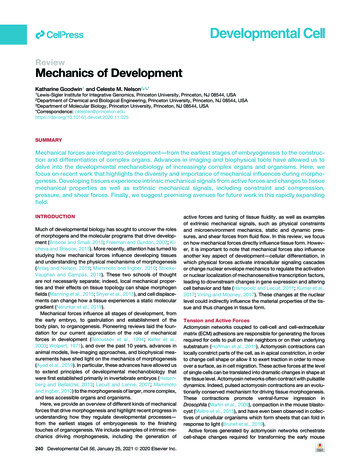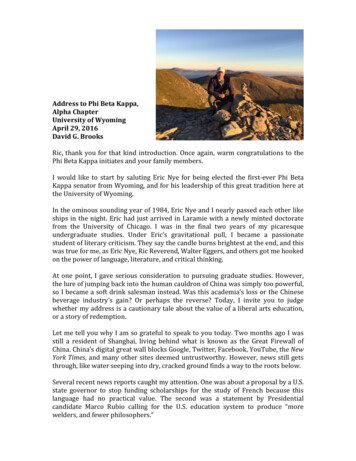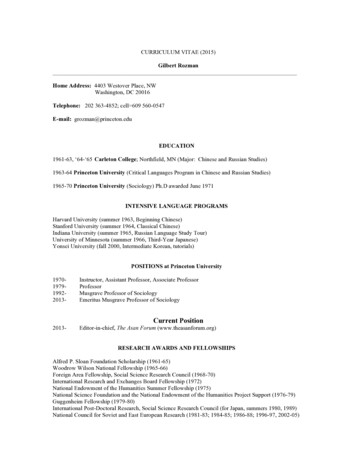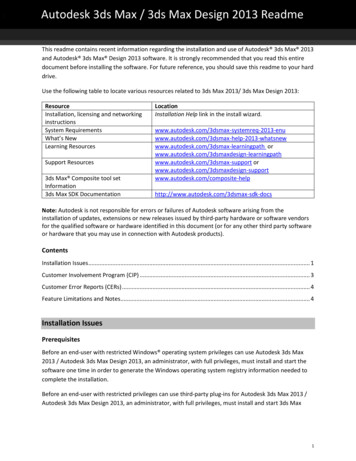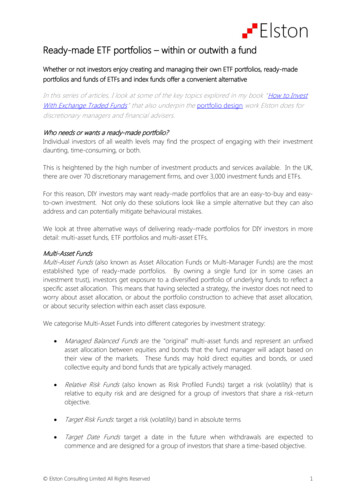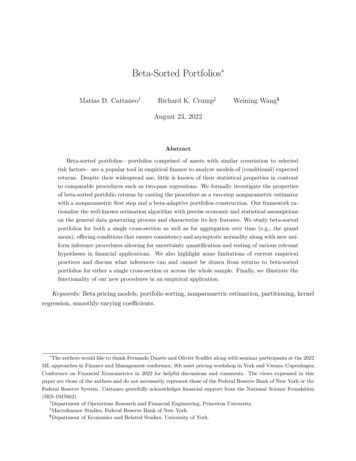
Transcription
Beta-Sorted Portfolios Matias D. Cattaneo†Richard K. Crump‡Weining Wang§August 23, 2022AbstractBeta-sorted portfolios—portfolios comprised of assets with similar covariation to selectedrisk factors—are a popular tool in empirical finance to analyze models of (conditional) expectedreturns. Despite their widespread use, little is known of their statistical properties in contrastto comparable procedures such as two-pass regressions. We formally investigate the propertiesof beta-sorted portfolio returns by casting the procedure as a two-step nonparametric estimatorwith a nonparametric first step and a beta-adaptive portfolios construction. Our framework rationalize the well-known estimation algorithm with precise economic and statistical assumptionson the general data generating process and characterize its key features. We study beta-sortedportfolios for both a single cross-section as well as for aggregation over time (e.g., the grandmean), offering conditions that ensure consistency and asymptotic normality along with new uniform inference procedures allowing for uncertainty quantification and testing of various relevanthypotheses in financial applications. We also highlight some limitations of current empiricalpractices and discuss what inferences can and cannot be drawn from returns to beta-sortedportfolios for either a single cross-section or across the whole sample. Finally, we illustrate thefunctionality of our new procedures in an empirical application.Keywords: Beta pricing models, portfolio sorting, nonparametric estimation, partitioning, kernelregression, smoothly-varying coefficients. The authors would like to thank Fernando Duarte and Olivier Scaillet along with seminar participants at the 2022ML approaches in Finance and Management conference, 9th asset pricing workshop in York and Vienna–CopenhagenConference on Financial Econometrics in 2022 for helpful discussions and comments. The views expressed in thispaper are those of the authors and do not necessarily represent those of the Federal Reserve Bank of New York or theFederal Reserve System. Cattaneo gratefully acknowledges financial support from the National Science Foundation(SES-1947662).†Department of Operations Research and Financial Engineering, Princeton University.‡Macrofinance Studies, Federal Reserve Bank of New York.§Department of Economics and Related Studies, University of York.
1IntroductionDeconstructing expected returns into idiosyncratic factor loadings and corresponding prices of riskfor interpretable factors is an evergreen pursuit in the empirical finance literature. When factorsare observable, there are two workhorse approaches that continue to enjoy widespread use. Thefirst approach, Fama-MacBeth two-pass regressions, have been extensively studied in the financialeconometrics literature.1 The second approach, which we refer to as beta-sorted portfolios, hasreceived scant attention in the econometrics literature despite its empirical popularity.2Beta-sorted portfolios are commonly characterized by the following two-step procedure, whichincorporates beta-adaptive portfolios construction. In a first step, time-varying risk factor exposuresare estimated through (backwards-looking) weighted time-series regressions of asset returns on theobserved factors. The most popular implementation uses rolling window regressions, often witha choice of a five-year window. In a second step, the estimated factor exposures, based on dataup to the previous period, are ordered and used to group assets into portfolios. These portfoliosthen represent assets with a similar degree of exposure to the risk factors, and the degree ofreturn differential for differently exposed assets is used to assess the compensation for bearing thiscommon risk. Most frequently this is achieved by differencing the portfolio returns from the twomost extreme portfolios. Finally, an average over time of these return differentials is taken to inferwhether the risk is priced unconditionally—whether the portfolio earns systematic (and significant)excess returns. Notwithstanding the simple and intuitive nature of the methodology, little is knownof the formal properties of this estimator and its associated inference procedures.We provide a comprehensive framework to study the economic and statistical properties ofbeta-sorted portfolios. We first translate the two-step estimation algorithm with beta-adaptiveportfolio construction into a corresponding statistical model. We show that the model has keyfeatures which are important to consider for valid interpretation of the empirical results. For1See, for example, Jagannathan and Wang (1998), Chen and Kan (2004), Shanken and Zhou (2007), Kleibergen(2009), Ang, Liu, and Schwarz (2020), Gospodinov, Kan, and Robotti (2014), Adrian, Crump, and Moench (2015),Bai and Zhou (2015), Bryzgalova (2015), Gagliardini, Ossola, and Scaillet (2016), Chordia, Goyal, and Shanken(2017), Kleibergen, Lingwei, and Zhan (2019), Raponi, Robotti, and Zaffaroni (2020), Giglio and Xiu (2021) andmany others. For a recent survey, see Gagliardini, Ossola, and Scaillet (2020).2The empirical literature using beta-sorted portfolios is extensive. For a textbook treatment, see Bali, Engle, andMurray (2016), and for a few recent papers see, for example, Boons, Duarte, De Roon, and Szymanowska (2020),Chen, Han, and Pan (2021), Eisdorfer, Froot, Ozik, and Sadka (2021), Goldberg and Nozawa (2021), and Fan,Londono, and Xiao (2022).1
example, in this setting, no-arbitrage conditions are not guaranteed to hold and instead implytestable hypotheses. Within this framework, we impose general sampling assumptions allowingfor smoothly-varying factor loadings, persistent (possibly nonstationary) factors, and conditionalheteroskedasticity across time and assets. We then study the asymptotic properties of the betasorted portfolio estimator and associated test statistics in settings with large cross-sectional andtime-series sample sizes (i.e., n, T ).We provide a host of new methodological and theoretical results. First, we introduce conditionsthat ensure consistency and asymptotic normality of the full-sample estimator of average expectedreturns. Importantly, we characterize precise conditions on the bandwidth sequence of the firststage kernel regression estimator, h, and the number of portfolios, J, relative to growth in n and T . We show that the rate of convergence of the estimator is only T , despite an effective samplesize of the order nT , reflecting specific properties of the setting of interest. However, we also showthat certain features of average expected returns such as the discrete second derivative—whichrepresents a butterfly spread trade—can be estimated with higher precision through faster rates ofconvergence, namely,pnT /J for a single risk factor. This result also accommodates more powerfultests for testing the null hypothesis of no-arbitrage. Finally, we also provide novel results on uniforminference for the beta-sorted portfolio estimator for both a single period and the grand mean. Thisfacilitates the construction of uniform confidence bands which allows for inference on a variety ofhypotheses of interest such as monotonicity or inference on maximum-return trading strategies.We also uncover some limitations of current empirical practice employing beta-sorted portfoliosmethodology. First, as with all nonparametric estimators, the choice of tuning parameters, h andJ, are key to successful performance and are dependent on the sample sizes n and T . In contrast,empirical practice often chooses window length in the first step and total portfolios in the secondstep irrespective of the sample size at hand. Second, we show that the Fama-MacBeth varianceestimator, is not consistent in general but only when conditional expected returns are constant overtime for a fixed beta. However, we show that the Fama-MacBeth variance estimator still leads tovalid, albeit possibly conservative, inferences. We also show that differential returns for a singletime period, often used as inputs for assessing the time-series properties of conditional expectedreturns, are contaminated by an additional term when risk factors are serially correlated.From a theoretical perspective, beta-sorted portfolios present a number of technical challenges2
originating from the two-step estimation algorithm with beta-adaptive portfolio construction, sinceit relies on two nested nonparametric estimation steps together with a portfolio construction basedon a first-step nonparametric generated regressor. More precisely, the first-stage nonparametricallyestimated factor loadings enter directly into the (non-smooth) partitioning scheme further complicating the analysis.3 To our knowledge, we are the first to prove validity of such an approach.This paper is most related to the large literature studying asset pricing models with observable factors.4 Given our focus on conditional asset pricing models with large panels in both thecross-section and time-series dimension, this paper is most closely related to Gagliardini, Ossola,and Scaillet (2016) (see also Gagliardini, Ossola, and Scaillet, 2020). Gagliardini, Ossola, andScaillet (2016) introduce a general framework and econometric methodology for inference in largedimensional conditional factors under no-arbitrage restrictions. They allow for risk exposures, whichare parametric functions of observable variables and provide conditions to consistently estimate,and conduct inference on the prices of risk. Although the statistical model under study shares important similarities with the setup of Gagliardini, Ossola, and Scaillet (2016), there are substantialdifferences, and the models explored previously in the literature do not nest our setup. For example,the classical beta-sorted portfolio estimator implies a data-generating process that does not (necessarily) exclude arbitrage opportunities and supposes risk exposures which are smoothly-varying.See Section 2 for more details.Our paper is also related to the financial econometrics literature on nonparametric estimationand inference. In particular, the two steps of the beta-sorted portfolio algorithm align individuallywith Ang and Kristensen (2012), who study kernel regression estimators of time-varying alphasand betas, and Cattaneo, Crump, Farrell, and Schaumburg (2020) who study portfolio sortingestimators given observed individual characteristic variables. However, the linkage between the twosteps, including the role of the generated (nonparametrically estimated) regressor in the second3For analysis of partitioning-based nonparametric estimators see Cattaneo, Farrell, and Feng (2020) and referencestherein. Partitioning-based estimators with random basis functions have been recently studied in Cattaneo, Crump,Farrell, and Schaumburg (2020) and Cattaneo, Crump, Farrell, and Feng (2022), but in those papers the conditingvariables are observed, while here the conditioning variable is generated using a preliminary time-series smoothlyvarying coefficients nonparametric regression, and therefore prior results are not applicable to the settings consideredherein.4See, for example, Goyal (2012), Nagel (2013), Gospodinov and Robotti (2013), or Gagliardini, Ossola, and Scaillet(2020) for surveys. A related literature endeavors to jointly estimate factor loadings and latent risk factors. See,for example, Connor and Linton (2007), Connor, Hagmann, and Linton (2012), Fan, Liao, and Wang (2016), Kelly,Pruitt, and Su (2019), Connor, Li, and Linton (2021), and Fan, Ke, Liao, and Neuhierl (2022), among others.3
stage nonparametric partitioning estimator has not been studied before. Finally, our paper is alsorelated to Raponi, Robotti, and Zaffaroni (2020) who study estimation and inference of the ex-postrisk premia. In analogy, we show that estimation and inference in our general setting are sensitiveto the specific object of interest chosen. For example, we show that a faster convergence rate ofthe estimator can be obtained by centering at realized systematic returns rather than conditionalexpected returns. See Section 4 for more details.This paper is organized as follows. In Section 2, we introduce our general data-generatingprocess and show how it rationalizes the two-step algorithm used to construct beta-sorted portfolios.In Section 3, we study the theoretical properties of the first-step estimators of the time-varyingrisk factor exposures. Using these results, in Section 4 we establish the theoretical propertiesof the second-step nonparametric estimator. To facilitate feasible inference, Section 5 introducespointwise and uniform inference procedures for the grand-mean estimator including characterizingthe properties of the commonly-used Fama-MacBeth variance estimator. In Section 6 we studypointwise and uniform inference procedures for a single cross-section and describe what propertiesof conditional expected returns are estimable. Section 7 presents an empirical application, andSection 8 concludes. Detailed assumptions and proofs of the results are relegated to the Appendix.Notation and conventionsIt is useful to introduce the following notation. For a constant k N and a vector v (v1 , . . . , vd ) PdRd , we denote v k (i 1 vi k )1/k , v v 2 and v maxi d vi . For a matrix A (aij )1 i m,1 j n , we define the spectral norm A 2 max v 1 Av , the max norm A max max1 i m,1 j n ai,j , A 1 max1 j nPmi 1 ai,j ,and A max1 i mPnj 1 ai,j .For a func-tion f, we denote f supx X f (x) , where X denotes the support. We set (an : n 1) and(bn : n 1) to be positive number sequences. We write an O(bn ) or an . bn (resp. an bn )if there exists a positive constant C such that an /bn C (resp. 1/C an /bn C) for all largen, and we denote an o(bn ) (resp. an bn ), if an /bn 0 (resp. an /bn C). Limits aretaken as n, T unless otherwise stated explicitly. plimXn X means that Xn P X. Ldenotes convergence in law. Define Xn OP (an ) : limn P( Xn δε an ) 0Xn oP (an ) : ε, δ 0 Nε,δ ε 0. Definesuch that P( Xn δan ) ε n Nε,δ . Let Xn .P an meansXn OP (an ).4
2Model setupWe introduce a general statistical model of asset returns and show how the proposed model naturallyaligns with the two steps that comprise the beta-sorted portfolio algorithm. We discuss the relevantproperties of the model especially with respect to the potential presence of arbitrage opportunities.2.1Modeling returnsLet Rit denote the return of asset i at time t.5 We assume that asset returns are generated by thelinear stochastic coefficient model,Rit αit βit ft εit ,i 1, · · · , nt ,t 1, · · · , T,(2.1)where αit R and βit Rd (d 1) are random coefficients which are measurable to a filtrationbased on the past information, ft is a vector of observable risk factors, and εit is an idiosyncraticerror term.6 We allow for an unbalanced panel, but assume that n nt nu and n nu , so thateach cross-section contributes to the asymptotic properties of the estimator.nt ,t 1nt ,tt ,t, (ft )t 1, (βit )i 1,t 1We define the filtration Fn,T,t 1 σ((αit )ni 1,t 1t 1 , (εit )i 1,t 1 ). Hereafter, wesuppress the n and T as in Fn,T,t 1 and denote it as Ft 1 for simplicity of notation. We define another cross-sectional invariant filtration Gt 1 . Suppose that βit Gβ (ηi , g1 , · · · , gt 1 , f1 , · · · , ft 1 , ωit ),where ηi is independent and identically distributed (i.i.d.) over i, gt are i.i.d. factors over t, and ωitare i.i.d. over t and i. Then, the cross-section invariant sigma field is Gt σ(f1 , · · · , ft , g1 , · · · , gt ).This setup may appear restrictive but is in fact general: we can always increase the dimension of therandom variables entering the sigma field to accommodate more complex designs. Consequently,without loss of generality, we assume E(ft Gt 1 ) E(ft Ft 1 ).To obtain the structural form of our model, we denote µt (β) as the conditional expected returnof an asset with risk exposure β. Thus,E(Rit Ft 1 ) µt (βit ),(2.2)5Throughout we will assume that Rit represent excess returns. In the case when Rit represent raw returns thenµt (0) may be interpreted as the zero-beta rate at time t.6For an alternative example of a random coefficient model tailored to a financial application, see Barras, Gagliardini, and Scaillet (2022).5
so that using equation (2.1) we have,µt (βit ) αit βit E(ft Ft 1 ).(2.3)Finally, combining equations (2.1) and (2.3), we obtain the structural formRit µt (βit ) βit (ft E[ft Ft 1 ]) εit .(2.4)To distinguish conditional expected returns, µt (βit ), from systematic realized returns, we defineMt (βit ) µt (βit ) βit (ft E[ft Ft 1 ]) αit βit ftto represent the latter object.Equation (2.4) may be compared to the the standard beta pricing model (e.g., Cochrane, 2005,Chapter 12) and generalizations thereof (e.g., Cochrane, 1996; Adrian, Crump, and Moench, 2015;Gagliardini, Ossola, and Scaillet, 2016). The most noteworthy difference between equation (2.4) isthe presence of the (possibly) nonlinear, time-varying function µt (βit ). When Rit represent excessreturns then the no-arbitrage restriction implies that µt (βit ) βit λt for some λt (Gagliardini,Ossola, and Scaillet, 2016). Our model nests, but does not require, the imposition of the absenceof arbitrage opportunities so thatRit µt (βit ) βit (ft E[ft Ft 1 ]) εit ,µt (βit ) βit λt ) {z βit λt βit (ft E[ft Ft 1 ]) εit .}deviation from no-arbitrageThe presence of this additional term representing the deviation from no-arbitrage restrictions can bemotivated by appealing to structural models which feature violations of the law of one price. Sucha setup as in equation (2.4) could arise, for example, in the margin-constraints model of Garleanuand Pedersen (2011) under the assumption that the security’s margin is a nonlinear function of itspast beta.To see why equation (2.4) rationalizes the beta-sorted portfolio algorithm, consider the twosteps in the case when d 1.6
Step 1: Estimation of αit and βit . For each individual asset, we calculate the local constantestimator for αit and βit as, b it0 , βbit0α 0 1 tXK((t t0 )/(T h))Xt Xt 0 1 1 tXt 1 K((t t0 )/(T h))Xt Rit ,(2.5)t 1where Xt (1, ft ) , K(·) is a kernel function and h a positive bandwidth determining the lengthof the rolling window. This construction purposely does not have “look-ahead bias”; moreover,b it0 and βbit0 do not use data from time t0 in their construction (a “leave-one-out”the estimators αestimator). This estimation of the time-varying random coefficients can be interpreted as a kernelregression of equation (2.1) for each cross-section unit. When K(·) takes on a constant value forthe most recent prior H time periods, and zero otherwise, we obtain the familiar rolling windowregression estimator with window size H. Step 2: Sorting portfolios using estimated βit . To see that this comprises cross-sectionalnonparametric estimation observe that, for fixed t, equation (2.2) is the conditional mean of interest.7 We define B [βl , βu ] as the support of the possible realizations of βit across i and t. For eacht 1, . . . , T , let us define a beta-adaptive partition of this support asPbjt [βb(bnt (j 1)/Jt c)t , βb(bnt j/Jt c)t ),Pbjt [βb(bnt (J 1)/Jc)t , βb(nt )t ],j 1, . . . Jt 1j Jt ,where b.c denotes the floor function and βb( )t denotes the th order statistic of the estimated betasin the first step across i for fixed t, i.e., the order statistics of {βbit : i 1, . . . , nt }. The number ofportfolios Jt , and their random structure (i.e., break-point positions based on estimated βit ), varyfor each time period. Then, definepbjt (β) 1{β Pbjt },7Cattaneo, Crump, Farrell, and Schaumburg (2020) provide a detailed discussion of how sorted portfolios representa nonparametric estimate of a conditional expectation. See also, Fama and French (2008), Cochrane (2011), andFreyberger, Neuhierl, and Weber (2020).7
b t [Φb i,j,t ] bbjt (βbit ).with 1{·} the indicator function, and Φnt Jt the matrix with element Φi,j,t pWe also let pbjt (β) be pbjt in later sections. We can then obtainb tΦb ) 1 (Φb t Rt ),bt (Φatbjt as thewhich represent the average returns of assets in Pbjt for j 1, . . . , Jt at time t. Define ajth element of ât .blt and abut be the portfolio returns of the two extreme portfolios, a common object ofLetting ainterest is the differential average returns in the most extreme portfolios:TT 1X1Xbt (βu ) µbt (βl ) ,but ablt ) µ(aT t 1T t 1wherebt (β) µJtXbjt .pbjt (β)a(2.6)j 1More generally, many other estimators of interest in finance can be defined as transformations ofbt (β) : β B), for each cross-section.the stochastic processes (µSimilarly, other estimators of interest can be considered by averaging across time. These estib(β) : β B) withmator can be thought of as transformations of the stochastic process (µb(β) µJtTT X1X1Xbt (β) bjt .µpbjt (β)aT t 1T t 1 j 1(2.7)For example, we can estimate conditional expected returns for all values of β rather than only valuesbt (β) and µb(β) may be directly interpreted as nonparametricnear βl and βu . Correspondingly, µestimators of conditional expected returns. A few comments are in order. First, the above two steps are completely in line with the empiricalfinance literature. Importantly, at no point in the two-step algorithm is there estimation of theconditional expectation of the risk factors, E[ft Ft 1 ], and so the researcher ostensibly remainsagnostic about the dynamics of these risk factors. We will revisit this issue in the next section.Second, the practice of moving-window regressions to accommodate time variation in βit suggestsa slowly-varying coefficient model as previously used in finance applications such as in Ang and8
Kristensen (2012) and Adrian, Crump, and Moench (2015). However, in contrast to these previousformulations, we do not condition on the realizations of the random processes αit and βit . Instead,we retain the randomness in these objects so that the second-stage beta-sorted portfolio estimatorcan have a well-defined limit as n, T . Third, an alternative to the smoothly-varying coefficientsapproach is to specify βit as a functions of individual characteristics and possibly also of economywide variables (see, for example, Gagliardini, Ossola, and Scaillet, 2020, and references therein).Our approach can straightforwardly accommodate such settings by modifying the kernel regressionsappropriately.Finally, the more general estimation approach described in equations (2.6) and (2.7), with moredetails in Section 4, does not constitute spurious generality. The conventional implementation ofbeta-sorted portfolios relies on a constant choice of Jt J t and so averages J portfolios across alltime periods. However, if the cross-sectional distribution of the βit are changing over time then thereis no guarantee that each portfolio represents assets with sufficiently similar betas. For example,it may be that assets with values of β near 1/2 fall in the sixth portfolio at times and the fifthportfolio at other times and so on. Thus, the conventional estimator will be, in general, both morebiased and more variable than the estimators suggested in equations (2.6) and (2.7), all else equal.This is of special importance when we are interested in expected returns for intermediate values ofbetas and also in situations where tests of monotonicity or shape restrictions are of interest.3First step: rolling regressionsThe first step involves a kernel regression of a linear stochastic coefficients model. Recall thatXt (1, ft ) and define bit (αit , βit ). Then, we can rewrite equation (2.1) asRit0 Xt 0 bit0 εit0 .We assume that E(εit Ft 1 ) Et 1 (εit ) 0 and, because αit and βit are measurable with respectto Ft 1 , then αit0 and βit0 can be identified asbit0 E(Xt0 Xt 0 Ft0 1 ) 1 E(Xt0 Rit0 Ft0 1 ).9
b it0 , βbit0 ) . In order to accommodate the randomThe kernel estimator from (2.5) is then bbit0 (αcoefficients we exploit the fact thatPt0 1t 1are close, in the appropriate sense, toK((t t0 )/(T h))Xt Xt andPt0 1t 1Pt0 1t 1K((t t0 )/(T h))Xt RitE[K((t t0 )/(T h))Xt Xt Ft 1 ] andPt0 1t 1E[K((t t0 )/(T h))Xt Rit Ft 1 ], since their difference are summands of martingale difference sequences.To formalize the intuition and establish uniform consistency and asymptotic normality of bbit0we require technical, but not controversial, assumptions on the underlying data generating process.We report these assumptions in the Appendix (Assumptions 1–6) and discuss them briefly here.Assumption 1 ensures that the one-sided kernel K(·) satisfies standard properties such as beingnonzero on a compact support and twice continuously differentiable. The one-sided kernel ensuresthat we do not have any look-ahead bias, so the procedure can be interpreted as real-time estimation,and also to define the appropriate conditional moments for the second step discussed in the nextsection. Assumption 2 imposes some structure on the time series properties of the factor ft butis quite general and allows for certain forms of nonstationary behavior. We could relax some ofthese assumptions to allow for even more complex time-series properties at the expense of moredetailed notation and proofs. Assumption 2 also imposes moment conditions on the idiosyncraticerror term, εit . Assumption 3 ensures that bit0 is well defined for all t0 . Assumptions 4 and 6are regularity conditions on the rate of decay of the time-series dependence of the risk factors.Finally, Assumption 5 ensures that the alphas and betas, although random, are sufficiently smoothover time (i.e., satisfying a Lipschitz-type condition). Similar assumptions are generally imposedin varying coefficient models (see, for example, Zhang and Wu, 2015).We first provide a uniform consistency results of our estimator bbit0 over i and t. We require thisresult to precisely control the effect of estimating βit in the first step when entering the second-stepestimator. We establish this consistency on a compact interval of a trimmed support with trimminglength bT hc. Let q denote the parameter in Assumption 2.Theorem 3.1. Suppose Assumptions 1–6 hold, and let rT (T h) 1 (T 1/q h 0, and log(nu T )/T h 0. Then,maxsup1 i n bT hc t0 T bT hcwhere δT (rT log(nu T )/ T h h).p10bbit0 bit0 .P δT , T h log T ) 0,
Theorem 3.1 provides uniform rates of convergence for the first-stage kernel estimators of thebetas. Naturally, these rates depend on n, T , and h but are also directly dependent on q whichrepresents the number of bounded moments of the idiosyncratic error term. For very large q,essentially the uniformity is attained at rate only slower by a log(T ) factor. Importantly, thetheorem shows that we attain the same uniform rate for the leave-one-out estimator which ensuresour theoretical results mimic empirical practice exactly.Although estimation of µ(·) is generally of interest, there are some situations where inference onβit directly is instead the primary goal. To introduce the necessary results we need to present someadditional useful notation. To allow for a flexible class of time series processes we model the factor,ft , as a sum of two components, ft τt xt , where τt is a smoothly-varying process and xt is astrictly stationary process.8 Then we can define τt τ 0 (t/T ) for a smooth function τ 0 : [0, 1] 7 R.Also define, Σx E[(1, xt )(1, xt ) ], τ̃ (t0 /T ) (1, τ 0 (t0 /T )) . We let ΣA Σx τ̃ (t0 /T )τ̃ (t0 /T ) ,2 E(X X )ΣB σε,0t0 t0R0 1 K2 (s)ds. 1 1 2Σb Σ 1A ΣB ΣA ΣA σε,0R0 1 K2 (s)ds.With these definitionsin place, we next show asymptotic normality of our estimator bbit0 . Theorem 3.2 (Asymptotic Normality). Let h hT 0, h 0, T h , rAT rT 0 then,under Assumptions 1-6, we have that 1/2T hΣb bbit0 bit0 L N(0, I).(3.1)where rAT is defined in equation (B.14) in the Appendix.We show in the appendix that the limiting asymptotic distribution is invariant to whether theleave-one-out or general kernel estimator is used. The results in Theorem 3.2 can to be extendedto distribution results which are uniform over t; however, we don’t pursue this here as our mainfocus is on the beta-sorted estimator. Finally, note that to construct a confidence interval for bit0based on bbit0 , we require a consistent estimator of the asymptotic variance of bbit0 . Using residualsfrom the initial step, i.e., εbit , σt2 can be estimated bybt20 , ςbt20 ) arg min(σc0 ,c1tXnt0 1 Xt 1 i 1K t t 0Th8 2εb2it c0 c1 (t t0 )/T .We could allow for even more general behavior in xt ; however, for simplicity we maintain the strict stationarityassumption.11
Rb can be obtained by T A(t0 ) 1 σb (t0 /T ) 01 K 2 (w)dw.So Σb4Second step: beta sortsThe second step of the estimation procedure is to sort assets by their value of βbit obtained fromthe procedure described in the previous section. Recall that the structural form of our model isRit µt (βit ) βit (ft E(ft Ft 1 )) εit Mt (βit ) εit ,and under our assumptions we have E(εit Ft 1 , βit ) E(εit Ft 1 ) 0.To gain intuition, suppose that the βit were observed. The second equality makes clear that,for a fixed t, we can only nonparametrically estimate the unknown function Mt (·) rather than thedirect object of interest µt (·); see Remark A.9 in the Appendix for a formal discussion. However,TTT1X1X1XMt (β) µt (β) β (ft E(ft Ft 1 )).T t 1T t 1T t 1(4.1)The second term has summands, β (ft E(ft Ft 1 )), which are a martingale difference sequencewith respect to Ft and so we would expect this sample average to converge to zero in probability;consequently, this would ensure that T 1PTt 1 Mt (β)and T 1PTt 1 µt (β)are uniformly (in β) closein probability for large T . A further complic
of beta-sorted portfolio returns by casting the procedure as a two-step nonparametric estimator with a nonparametric first step and a beta-adaptive portfolios construction. . Cattaneo gratefully acknowledges financial support from the National Science Foundation . (2015),Bryzgalova(2015),Gagliardini, Ossola, and Scaillet(2016),Chordia .
